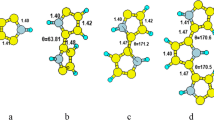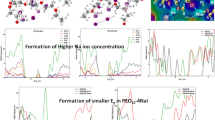Abstract
A tight-binding model describing the xPPP/yPA diblock copolymer has been adopted. The ground states, doping states, configurations, electronic distributions and the types of excitations have been studied. It is found that the ratios and interfacial couplings of the components have effect on the properties of excitations in xPPP/yPA diblock copolymers. The interface between two homopolymers acts as an energy barrier which increases with the weakening of the interfacial coupling.
Similar content being viewed by others
References
Burroughes, J. H., Bradley, D. D. C., Brown, A. R. et al., Light-emitting diodes based on conjugated polymers, Nature, 1990, 347(11): 539.
Parker, I.D., Carrier tunneling and device characteristics in polymer light-emitting diodes, J. Appl. Phys., 1994, 75(3): 1656.
Gustafsson, G., Cao, Y., Treacy, G. M. et a1., Flexible light-emitting diodes made from soluble conducting polymers, Nature, 1992, 347(11): 477.
Braun, D., Heeger, A. J., Visible light emission fmm emission from semicondicting polymer diodes, Appl. Phys. Lett., 1982, 58(18): 1982.
Ma, D., Hümmelgen, I. A., Hu, B. et al., Determination of electron mobility in a blue-emitting alternating block copolymer by space-charge-limited current measurements, Solid State Comm., 1999, 112(5): 251.
Martens, H. C. F., Blom, P. W. M., Schoo, H. F. M., Comparative study of hole transport in poly(p-phenylene viny- lene) derivatives, Phys. Rev. B, 2000, 61(11): 7489.
Beljonne, D., Comil, J., Silbey, R. et a1., Interchain interactions in conjugated materials: The exciton model versus the supermolecular approach, J. Chem. Phys., 2000, 112(10): 4749.
Yu, G., Heeger, A. J., High efficiency photonic devices made with semiconducting polymers, Synth. Met., 1997, 85(1-3): 1183.
Martin, S. J., Bradley, D. D. C., Lane, P. A. et al., Linear and nonlinear optical of the conjugated polymers PPV and MEH-PPVPhys. Rev., B, 1999, 59(23): 15133.
Nguyen, T. P., Chen, L. C., Wang, X. et a1., Multilayer light emitting diodes using a PPV based copolymer, Opt. Mater., 1998, 94(1-4): 154.
Hayashi, K., Tsubakihara, H., Kubo, U., Doping effect on the electronic and molecular structure of a vinylidenefluoride- trifluoroethylene copolymer, Jpn. J. Appl. Phys., 1997, 36(3 A): 1176.
Blatchford, J. W., Jessen, S. W., Lin, L. B., Exciton dynamics in poly(p-pyridyl vinylene), Phys. Rev. Lett., 1996, 76(9): 1513.
Costa da, Gomes P., Conwell, E. M., Persistent photo conductivity in poly(p-phenylenevinylene): Spectral response and slow relaxation, Phys. Rev. B, 1993, 48 (23): 15543.
Leng, J. M., Jeglinski S., Wei X. et al., Optical probes of excited states in ply(p-Phenylenevinylene), Phys. Rev. Lett., 1994,72(1): 156.
Zojer, E., Comil, J., Leising, G. et a1., Theoretical investigation of the geometric and optical properties of neutral and charged oligophenylenes, Phys. Rev. B, 1999, 59(12): 7957.
Liu, D. S., Mei, L. M., Xie, S. J. et al., Electronic structure of polyacetylene and poly(p-phenylene) diblock copoly- mers, J. Phys.: Condens. Matter, 2000, 12: 4333.
Su, W. P., Scbrieffer, J. R., Heeger, A. J., Solitons in pouavetylene, Phys. Rev. Lett., 1979, 42 (25): 1698.
Xie, S. J., Mei, L. M., Sun, X., Ground state and polaron and bipolaron excitations in poly (p-phenylene), Acta Physica Sinica, 1989, 38: 1506.
Hu, B., Zhang, N., Karasz, F. E., Good quality Al/SiNx: H/InP metal-insulator-semiconductor devices obtained with electron cyclotron resonance plasma method, J. Appl. Phys., 1998, 83 (1): 600.
Meyers, F., Heeger, A. J., Bredas, J. L., Fine tuning of the band gap in conjugated polymers via control of block copolymer sequence, J.Chem.Phys., 1992, 97(4): 2750.
Liu, D.S., Xie, S. J., Mei, L. M., Study of the electronic structure of diblock copolymers, Acta Physica Sinica, 2000, 49: 1556.
Leising, G., Pichler, K., Stelzer, F., Electronic Properties of Conjugated Polymers (eds. Kuzmany, H., Mehring, M., Roth, S.), Heidelberg: Springer-Verlag, 1989, 100.
Moses, D., Feldblum, A., Denenstein, A. et al., Pressure dependence of the photoabsorption of polyacetylene, Phys. Rev. B, 1982, 26(6): 3361.
le, S., Lischka, H., Combined ab initio and density functional study on polaron to bipolaron transitions in oligophenyls and oligothiophenes, J. Chem. Phys., 1997, 107(8): 3021.
Author information
Authors and Affiliations
Corresponding author
Rights and permissions
About this article
Cite this article
Liu, D., Wang, L., Wei, J. et al. Doping states of xPPP/yPA diblock copolymers. Sci. China Ser. A-Math. 45, 648–654 (2002). https://doi.org/10.1360/02ys9070
Received:
Issue Date:
DOI: https://doi.org/10.1360/02ys9070




